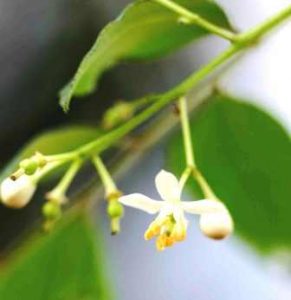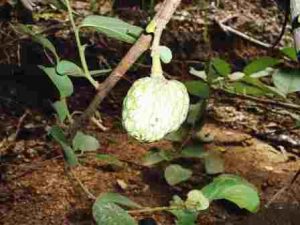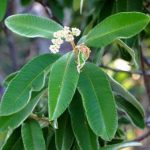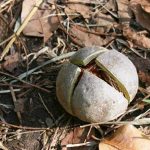TREE LIFE
December 1998
MASHONALAND CALENDAR
Tuesday 1st December: Botanic Garden Walk. Our walk in the economic section continues and we will also have a look at more of the little known and seldom seen species on Mark’s list. We will meet Tom in the car park at 4.45 for 5 p.m. – there will be a guard for the cars.
Sunday 6th December: Mr. Bill Clarke has kindly offered his property Val D’Or, for this month’s venue. As is usual in December we will hold our Christmas Social. Phil has agreed to be the leader of Tree Bingo, so fun and learning is guaranteed. Please bring a pen.
Bring your lunch and if possible a cake or something to share for tea which will be served at 9.30 a.m. before we set out.
Saturday 2nd January: Mark’s Botanic Walk
Tuesday 6th January: Botanic Garden Walk
MATABELELAND CALENDAR
Sunday 6th December: Gill Short will lead the walk at Mazwi, meet at Girls’ College car park at 8 a.m. for an 8.30 start.
Friday 1st January: Our New Year Social will probably be held at Jonathan Timberlake’s home. A little nearer the time please phone Jonathan at home or Gill Short to confirm details.
BOTANIC GARDEN WALK: 3 NOVEMBER 1998
An unusual subject today – the woody plants in the Economic section of the Gardens. This is not a section I remember ever having looked at before and it contained much of interest.
On the way through the Gardens we passed, just outside the Desert House, a remarkable-looking species of Pachypodium from Madagascar. It was about 2-3 metres high with a bunch of white flowers at the top of a swollen trunk covered with spines. On looking at the inflorescence closely paired fruits typical of the family Apocynaceae were noticed.
Spondias mombin, a tropical American tree, known as the Golden Mombin, was nearby. It belongs to the Anacardiaceae and is grown for its fruit. The leaves are imparipinnate and it bears its small white flowers in pyramidal panicles at the branch ends. Later, we were shown another Spondias, namely Spondias cytherea. This is also grown for its fruit, which are used in pickles and jellies. It looked generally rather similar to Spondias mombin. Tom mentioned that it produces few fruit in the Gardens as it is out of its normal climatic range.

Clausena anisata. Photo: Bart Wursten. Source: Flora of Zimbabwe
A shrub, which is related to one of our indigenous trees, was Clausena lansium. It is also known as the Wampi and comes from China. It is cultivated for its lime-like fruit. The leaves were compound (like our Clausena anisata) but were strongly crisped at the edges and also lacked the strong aroma of anisata.
Nearby also was the Curry Leaf. Tom mentioned that this was one of about twenty species that may be used in making curry. It is an Indian tree called Murraya koenigii. The family is the same as Clausena, that is the Rutaceae, and typical of the family were the translucent glands dotted strongly throughout the leaf lamina.
Grasses were not neglected. We looked at a fine specimen of the Giant Bamboo, Dendrocalamus giganteus, which comes from Burma. The enormous culms are used as scaffolding in Hong Kong. Nearby were three species of Phyllostachys, another bamboo. The young shoots of some of these species are the edible “bamboo shoots”.

Annona senegalensis. Photo: Mark Hyde. Source: Flora of Zimbabwe
A genus of great commercial importance is Annona in the Annonaceae. We of course have two native species and one of these, Annona senegalensis, was described by Tom as one of the nicest wild fruits to eat. In Annona, the fruits, which are separate carpels in some members of the family, e.g. Friesodielsia, are here fused into a single fruit. The places where the carpels join are represented by markings on the fruit.
One species of Annona in particular, probably Annona reticulata, has quite a large fruit, which looks rather like the fruit of Monodora. It also had very narrow leaves. This particular tree was grown from seed from Haiti and its exact name remains a bit of a mystery.
Later we looked at Annona squamosa, another custard apple that was a small-leaved shrub and an Annona muricata, the Soursop. The later had obovate leaves and remarkable fruits covered in prickles. Annona cherimola is said to have the most edible fruit of all. It has white flowers. These cultivated species are mainly C and S American in origin.
An attractive species was Malpighia glabra, the West Indies Cherry. This had small purple flowers with long-clawed petals. The fruit is rich in vitamins and has been introduced into the Communal Lands in Zimbabwe, but as the fruit is rather sour it was not successful. Commercially, it is used in making syrups and jam.
The rubber tree, Hevea brasiliensis, was also shown to us. It is a South American tree from the Euphorbiaceae – obviously it is one that produces latex and the one in the Botanic Gardens certainly did so. The leaves are three-lobed.
Finally, an intriguing tree seen was Hovenia dulcis. It is known as the Raisin Tree and has a branched inflorescence, the stalks of which become fleshy and edible.
All in all, it was a most interesting session. Although many of the trees were unfamiliar, it was fascinating to note the many relationships that exist with our native flora.
Once again, our thanks go to Tom for making the subject so interesting.
-Mark Hyde
–
Dear Tree People,
Some of you will remember me and my unusual habits – a creeper, a straggler, bushy, a climber (only when absolutely necessary), quite tall and ever hopeful of being sylph-like and sapling slender!! I would like to invite you (am appealing to all of you now???) to share some of these habits with me this rainy season.
I have recently had the very good fortune of spending five weeks in Belgium and one week at Kew, being trained in matters concerning the secret life of fungi. This was fascinating and if at all possible, increased my passion for fungi even more! I came away with so many new species, one of which is a netball Fungus or Clathrus. The description has gone back to Belgium for review but during the course of that study, I discovered that we have five distinct species of Clathrus in Zimbabwe, most of which have only been photographed and have no accompanying specimens.
Most importantly, I need specimens but they are smelly, very difficult to collect and very short-lived (lasting no more than 2 hours!). I would like samples of the ‘eggs’ before they ‘hatch’ into the beautiful net-like structure and also the opened netball. Please preserve them in a wide-mouthed bottle of meths or similar alcohol (not your favourite whisky – there is a limit on the lengths to which mycologists will go in their search for knowledge!) If no alcohol is available, you can press the specimen as you do your tree samples. The original colour must be recorded as this may fade by the time I see it. Of course, I would be delighted to have good photographs/slides of the fungus in the event that I can publish my findings.
The second group of fungi that need more attention are the Termite Fungi (Termitomyces).
December and January are the months that these fungi emerge from their termitaria and I need you to put aside at least two fresh specimens before you eat them for breakfast, dry them in your warming-drawer or very cool oven. The flies get to these fungi very quickly so you may have to spray the specimens with an ordinary fly-spray before you try and dry them, otherwise you will have a disgusting mess of fat, writhing maggots in your oven! Left too long, these could make an interesting, mushroom-flavoured snack a la Zimbabwe!
Getting back to alcohol and my search for knowledge, please try and find some soldier termites (the bigger ones with enlarged heads that bite!) from the mound where you have collected your mushrooms, and preserve them in meths etc. These must be correctly labelled to correspond with the mushroom so that I can try to establish which species of termite cultivates which species of fungus.
So while you are all out there busy ‘treeing’, I would be very grateful if you could keep an eye out for these two groups of fungi and collect and record where possible. All dried fungi specimens must be kept in PAPER packets/envelopes, packed carefully and sent on to me or left for my attention at the addresses listed below. Your help in obtaining national coverage in these two projects will be greatly appreciated and due acknowledgement for your contributions will be given in any resultant publications.
Thanking you in anticipation of hundreds of surprise packages!
Mrs. Cathy Sharp.
FRANKINCENSE OMAN’S IMMORTAL FRAGRANCE
The Arabic name is Luban, the Greeks called it libanos and the Romans knew it as olibanum. In Persia and India its name was condu, and in Germany and France incense. In English the name is Frankincense. This gum resin, harvested from the tree botanically named Boswellia sacra, has been used since prehistoric times for ritualistic, religious and medicinal purposes. However, the only place in the world where the frankincense tree is indigenous is Dhofar, the Southern Region of the Sultanate of Oman. It is from Dhofar that for thousands of years this precious commodity, once literally priced by its weight in gold, has been exported to the far corners of the known world. From the hinterland of the southern coastal plain of Oman frankincense has travelled by camel caravan and sea to the temples of Ancient Babylon, Pharaonic Egypt, India and China. The Queen of Sheba visited King Solomon in order to ratify a frankincense trade treaty, and King Herod of Egypt ordered frankincense to be burnt as an antiseptic during the Great Plague.
The unique climate of Dhofar is superbly suited to the growth and spread of the wild frankincense tree. The mountain range that surrounds the southern capital of Salalah’s coastal plain, the Jebel Dhofar, catches the southwest monsoon from Africa. The resultant rainfall on the hills and plain creates a very humid atmosphere in the north-eastern valleys and slopes of the mountain range which do not catch the rain and this humidity, together with the limey soil, encourages the growth of the frankincense tree. The trees cover a large area of land, mostly in Negd, the dry belt to the north of the mountains. The frankincense area stretches from the north east of Dhofar, opposite the islands of Kuria Muria, to the south-western border and beyond into Southern Yemen. The belt of trees is densest in the east, and about 80 kilometres wide here, and narrows gradually to the west where it fades away completely in Mahara lands of South Yemen.
The frankincense tree has a long life, and when mature reaches a height of about three metres. It takes about eight to ten years for a young tree to reach the right stage to be tapped for the precious harvest of resin. There are both male and female trees, known respectively as Golf (female) and Tays (male). The bulk of the harvest is culled from the male trees. The extraction of the frankincense is done with an instrument known as a Manghaf, a wooden pole with an iron blade attached. On each tree up to thirty incisions are made into the bark and the fluid which seeps out is left to harden into slightly sticky nodules on the tree for two to three weeks before being broken off and collected. Each tree is incised between three and four times in the season of four months or so, and then the trees are left to rest until the next year.
Traditionally, the frankincense plantations were known as manzanil, a single one being called a manzilah. They were clearly defined by boundary stone and trenches, and each was tended by a branch of the local tribe.
Legend has it that the owners were helped in their task of protecting the valuable frankincense by special guardians, namely small multi-coloured winged serpents. These flew in large swarms from tree to tree, belching fire and smoke as they went. The families who looked after the trees were highly respected in the community, and the men who tapped the trees would undertake special purification rites before starting this task.
Although some frankincense is produced elsewhere, the Dhofari crystals have always been regarded as the very best. There are four grades of frankincense, ranging from the finest, which is called Alhoraji through Alnajdi, and Asshazri down to Asshabi. The poorer grades came from the areas where there is quite heavy rainfall, on the plain and southern slopes of the Jebel. The most expensive frankincense is highly transparent and white in colour with a faint bluish tinge, the redder the colour the poorer the quality. Quite often the frankincense lumps will be covered with a fine white powder, which is the dust that forms as the lumps are rubbed together. The frankincense was graded at the manzanil and stored here, until it began its long journey by sea or across the Empty Quarter by caravan to its final destination.
The first stage in the journey was to a collecting station. There were several of these on the coast, near the ports, and three major ones to the north of the Jebel, at Ayum Hanoon and Andhur. The latter was famous for producing the best quality resin, and Hanoon was famous for the sheer quantity of produce. The ruins of these fortified oases can still be seen today. At the end of the wet season, when it was dry enough to travel easily through the Jebel, the frankincense would be sent down to the ports for export. There were two major ports, that of Sumharam at Khor Ron, and the other at the ancient site of the city of Salalah, as well as the ports at Taqah, Mughsayl and Al Baleed. The site of Sumharam port, now sadly silted up by a sand bar, can be very clearly seen from the Jebel hills above the inlet. It formed an excellent safe harbour for Shipping against pirates and monsoon winds, and enjoyed its busiest period during the first millennium BC Ancient records state that King Solomon’s ships anchored here, and jars of frankincense were rolled down the slopes of the surrounding hills into the holds of the ship. Al Baleed gained prominence in the first century AD and continued to expand as a large commercial centre until the Middle Ages. In the 13th century AD Marco Polo recorded the export of frankincense to China from this port.
Pliny records some two-and-a-half thousand tons of frankincense per year being exported through Al Baleed, and the total harvest from Dhofar when the industry was at its height reached some six-and-a-half thousand tons per year. Much of this left the country by small in-shore craft sailing west to the east African coast and east to Asia with the aid of the seasonal monsoon winds. The second export route was overland, by caravan. Frankincense was originally transported by donkey; camels came into use in the tenth century BC, and led to the establishment of major trade routes across the Arabian Peninsula to the Mediterranean and thence northwards and westwards to Europe. Frankincense was such a valuable commodity that these roads were closely guarded and heavy taxes were levied by the rulers of the countries through which it journeyed.
For thousands of years the frankincense trade flourished, providing the civilised world with one of its most prized commodities. It was used by the Ancient Egyptians for embalming the Pharaohs, and pellets were found in the tomb of Tutankhamen. King Solomon used it to scent his throne room, and tons of frankincense was burnt each year in the Assyrian temple of Baal. The Greeks used it to invoke the oracle at Delphi, and for millennia it has been synonymous with religious ritual. So valuable, it was always the prerogative of kings and princes; the Roman senators took their oath of loyalty to the emperor in the light of a burning incense brazier. Pliny records that the Emperor Nero burnt more frankincense at the burial of his wife Poppea than the annual production from the whole of Arabia. Interestingly, the various uses to which frankincense has been put are based on medical fact. When burnt, frankincense gives off phenol fumes that are antiseptic. The Prophet Moses used it for that purpose and it has been used constantly through the centuries as a healing antiseptic balm. Priests have used it to fend off infection when exposed to large numbers of worshippers and doctors have found it valuable in the treatment of various digestive and skin infections.
Despite the demise of frankincense production on a large scale in Dhofar since the end of the Second World War, when India imposed heavy taxes on its importation, and an artificial substitute was formulated, to this day it remains a valued commodity. It is used as a fixative in perfumes, notable in that most luxurious of fragrances, Oman’s own Amouage. People from Dhofar still use it as a medicine, often putting a few lumps into drinking water to purify it. It is burnt as an aromatic at weddings, and as an insect repellent in the evenings. Homeopathic medicine recommends it as a mild antiseptic, and in the form of a volatile oil it is highly beneficial to an ageing skin. The towns of Dhofar still make their own local styles of clay incense burner and frankincense is burnt on festive occasions to delight guests at social gatherings when the incense burner is offered by the host after the meal. And the best reminder of all – the heady scent of a small lump burnt in the cigarette lighter of your car – will link you at once with one of the world’s most prized substances.
SE Pollard in “A tribute to Oman – National Day in 1987”
And Thank You Phil for sourcing this topical and interesting article.
ANDY MACNAUGHTAN CHAIRMAN



